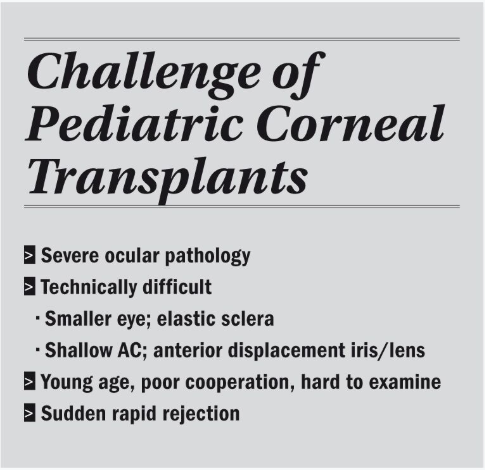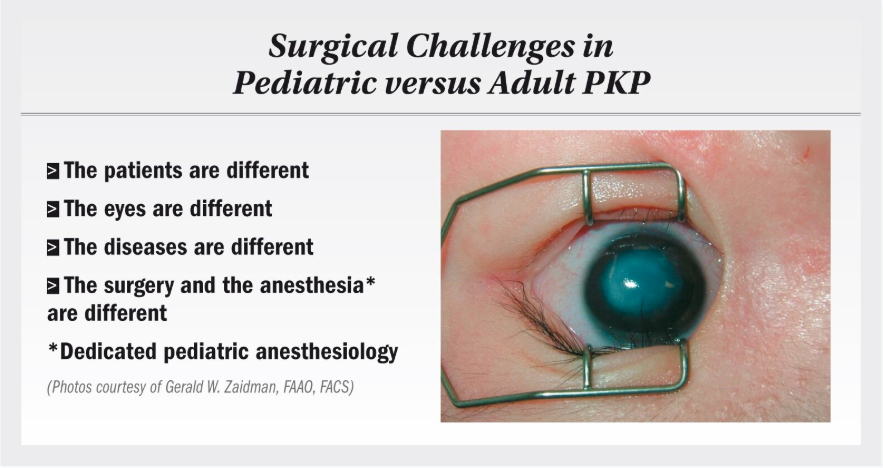Article
7 pearls for penetrating keratoplasty in pediatrics
Author(s):
Evaluate patients’ social situations; educate parents about their participation





Surgeons can achieve good visual results in children with corneal diseases by following these pearls.
Reviewed by Gerald W. Zaidman, FAAO, FACS
Corneal diseases are thought to be responsible for 10% of worldwide blindness in young patients and are frequent causes of blindness in developed and underdeveloped countries. However, unlike in adults, these diseases are more challenging in children, said Gerald W. Zaidman, MD.
“The patients are different,” said Dr. Zaidman, professor of ophthalmology, New York Medical College, and vice chairman of ophthalmology, Westchester Medical Center, both in Valhalla, NY.
“The eyes are different,” he said. “The diseases are different. The surgery and the anesthesia are different.” Dr. Zaidman shared pearls for achieving successful outcomes before and after penetrating keratoplasty (PKP) in these patients.
Examination under anesthesia
The youngest patients undergo examination under anesthesia (EUA), because it is crucial to diagnose and manage children with a cloudy cornea accurately. The standard examination includes measurement of the refraction (if possible), IOP, corneal diameter, slit lamp evaluation, A/B-scan ultrasonography, and ultrasound biomicroscopy (UBM).
Pediatric transplant cases are especially challenging because of the severity of ocular pathologies, technical difficulties of operating on small eyes with elastic sclera, shallow anterior chambers, and anterior displacement of the iris and lens. The youngest patients are unable to cooperate and hard to examine. In addition, sudden rapid graft rejection can occur in these patients.
The indications for corneal transplantation in children include congenital disorders, which accounts for 65% such as Peters anomaly, sclerocornea, congenital hereditary, endothelial dystrophy, and congenital glaucoma; followed by acquired non-traumatic diseases in 20% of patients, such as keratoconus, herpes simplex virus (HSV), corneal ulcers, rosacea, and regrafts, and finally, trauma in 10%. This is in contrast to adults in whom endothelial disease accounts for 45% of cases, keratoconus 35%, failed grafts 15%, and finally, scars/opacities, according to Dr. Zaidman.
Parental involvement
Importantly, when evaluating and treating pediatric patients, surgeons have to be concerned with more than just the surgery itself.
This means evaluating the patients’ social situations and educating the parents about their participation in what he referred to as the “marathon” of office visits, EUAs, and drop instillation postoperatively.
“Surgeons must discuss with parents the realistic success rates in pediatric transplantation cases, and that a clear graft does not equal good vision,” he said
Early surgery
The timetable itself for infants with a congenital disorder can be daunting. The office visits begin before 3 weeks of age, and EUAs are performed from 4 to 6 weeks of age. Surgery in the first eye is performed between 8 to 12 weeks of age and in the second eye from 4 to 6 weeks after the first surgery. General anesthesia is administered (mannitol, hyperventilation).
Donor tissue is used from donors 4 to 19 years old; the donor tissue is oversized by 0.5 mm. A scleral support ring is put in place and the anterior chamber is entered carefully and a viscoelastic injected. Synechialysis then is performed.
‘Sandwich technique’ and suture removal
A special technique is used to excise the host cornea in children. This technique is designed to minimize the severe amount of positive pressure that pediatric corneal surgeons encounter during the surgery. It is called the “sandwich technique,” in which the donor cornea is placed onto the host cornea and sutured into position into the recipient’s sclera.
The recipient’s cornea then is slid out from under the donor cornea, avoiding vitreous/ lens prolapse. Interrupted sutures then are used to adhere the graft in place, Dr. Zaidman explained.
During the first 2 months postoperatively, the patient is examined two to three times weekly. EUAs are performed frequently during the early postoperative period, and the sutures are removed early during that period.
Over the long term, topical steroids are tapered slowly over the course of 1 year. Sedation is administered as needed.
‘No’ to vaccinations, ‘yes’ to oral medication
“The children receive no vaccinations during the first year postoperatively,” Dr. Zaidman said.
He also pointed out the importance of both co-management with a pediatric ophthalmologist and optical correction as soon as possible after the sutures are removed.
The long-term visual outcomes of PKP in children with Peters anomaly type I are often quite good.
Dr. Zaidman reported that at 3 years postoperatively, 90% of the eyes with Peters type I have clear grafts (2 regrafts), 29% have 20/50 or better, 25% of eyes have 20/60 to 20/100, and 54% of eyes have 20/100 or better vision. In his hands, no eyes were lost, and none had no light perception vision.
Most eyes with visual acuity of 20/200 or worse had glaucoma. Similar results also were reflected in the Australian Corneal Graft Registry, 1985-2009.
A total of 765 patients younger than 20 years was identified. In children younger than 5 years, 65% had Peters anomaly or a congenital defect and of these more than half (56%) had clear grafts.
Sixty-two percent of the children ranging in age from 5 to 12 years had keratoconus or an opacity or scar due to trauma or HSV; in 80% the grafts were clear. In children who were 13 to 19 years of age, 86% had keratoconus, and 90% had a clear graft. Endothelial rejection was the most common cause of graft failure, and glaucoma was the most common cause of poor vision.
Disclosures:

Gerald W. Zaidman, FAAO, FACS
E: pedkera@aol.com
Dr. Zaidman did not indicate any proprietary interest in the subject matter.
Newsletter
Don’t miss out—get Ophthalmology Times updates on the latest clinical advancements and expert interviews, straight to your inbox.




